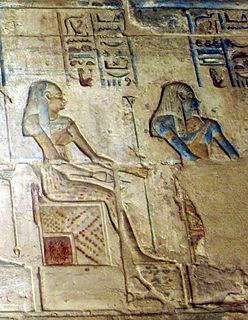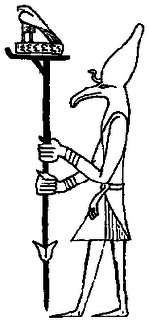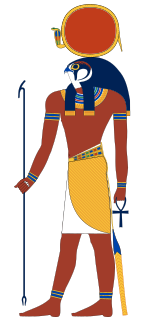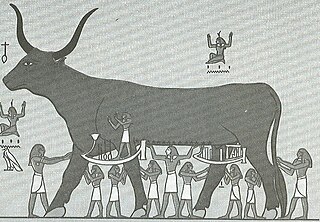
Anubis or Inpu, Anpu in Ancient Egyptian is the Greek name of the god of death, mummification, embalming, the afterlife, cemeteries, tombs, and the Underworld, in ancient Egyptian religion, usually depicted as a canine or a man with a canine head. Archeologists have identified Anubis's sacred animal as an Egyptian canid, the African golden wolf. The African wolf was formerly called the "African golden jackal", until a 2015 genetic analysis updated the taxonomy and the common name for the species. As a result, Anubis is often referred to as having a "jackal" head, but this "jackal" is now more properly called a "wolf".

The Book of Exodus is the second book of the Bible. Starting with the deliverance of Moses by Pharaoh's daughter, it recounts the revelation at the Burning bush where he was called by Yahweh to deliver the Israelites from Egyptian slavery. After Pharaoh rejected his and Aaron's demands, according to the book, the Almighty inflicted ten Plagues on Egypt resulting in the Exodus. The Mosaic covenant was made at the biblical Mount Sinai, and subsequently the Tabernacle, with a "divine indwelling" of God with Israel.

Thoth is an ancient Egyptian deity. In art, he was often depicted as a man with the head of an ibis or a baboon, animals sacred to him. His feminine counterpart was Seshat, and his wife was Ma'at. He was the god of the moon, wisdom, writing, hieroglyphs, science, magic, art, and judgment. His Greek equivalent is Hermes.

Nu, feminine Naunet, is the deification of the primordial watery abyss in the Hermopolitan Ogdoad cosmogony of ancient Egyptian religion. The name is paralleled with nen "inactivity" in a play of words in, "I raised them up from out of the watery mass [nu], out of inactivity [nen]". The name has also been compared to the Coptic noun "abyss; deep".
Nu is the one of the eight deities of the Ogdoad representing ancient Egyptian primordial Chaos from which the Primeval Mound appeared. He is coupled with goddess Naunet and appears in anthropomorphic form but with the head of a frog. No cult is addressed to Nun but he is typically depicted in ancient Egyptian art holding aloft the solar barque or the sun disc. He may appear greeting the rising sun in the guise of a baboon. Nun is otherwise symbolized by the presence of a sacred cistern or lake as in the sanctuaries of Karnak and Dendara.
Ḥeḥ was the personification of infinity or eternity in the Ogdoad in Egyptian mythology. His name originally meant "flood", referring to the watery chaos that the Egyptians believed existed before the creation of the world. The Egyptians envisioned this chaos as infinite, in contrast with the finite created world, so Heh personified this aspect of the primordial waters. Heh's female counterpart was known as Hauhet, which is simply the feminine form of his name.
Renpet was, in the Egyptian language, the word for "year". Its hieroglyph was figuratively depicted in art as a woman wearing a palm shoot over her head. She was often referred to as the Mistress of Eternity and also personified fertility, youth and spring. The glyph regularly appears on monuments and documents throughout Egyptian history as the beginning of the phrase recording the regnal year of the pharaoh.

Ash was the ancient Egyptian god of oases, as well as the vineyards of the western Nile Delta and thus was viewed as a benign deity. Flinders Petrie in his 1923 expedition to the Saqqara found several references to Ash in Old Kingdom wine jar seals: "I am refreshed by this Ash" was a common inscription.

The Plagues of Egypt, in the story of the book of Exodus, are ten disasters inflicted on Egypt by the God of Israel in order to convince the Pharaoh to allow the Israelites to depart from slavery, each of them confronting Pharaoh and one of his Egyptian gods; they serve as "signs and marvels" given by God to answer Pharaoh's taunt that he does not know Yahweh: "The Egyptians shall know that I am the LORD".

This is an index of Egyptian mythology articles.
He is the fifth letter of the Semitic abjads, including Phoenician Hē , Hebrew Hē ה, Aramaic Hē , Syriac Hē ܗ, and Arabic Hāʾ ه. Its sound value is a voiceless glottal fricative.

Ra or Re was the ancient Egyptian deity of the sun. By the Fifth Dynasty, in the 25th and 24th centuries BC, he had become one of the most important gods in ancient Egyptian religion, identified primarily with the noon-day sun. Ra was believed to rule in all parts of the created world: the sky, the Earth, and the underworld. He was the god of the sun, order, kings and the sky.

The Book of the Heavenly Cow, or the Book of the Cow of Heaven, is an Ancient Egyptian text thought to have originated during the Amarna Period and, in part, describes the reasons for the imperfect state of the world in terms of humankind's rebellion against the supreme sun god, Ra. Divine punishment was inflicted through the goddess Hathor, with the survivors suffering through separation from Ra, who now resided in the sky on the back of Nut, the heavenly cow.

Heqet, sometimes spelled Heket, is an Egyptian goddess of fertility, identified with Hathor, represented in the form of a frog. To the Egyptians, the frog was an ancient symbol of fertility, related to the annual flooding of the Nile. Heqet was originally the female counterpart of Khnum, or the wife of Khnum by whom she became the mother of Her-ur. It has been proposed that her name is the origin of the name of Hecate, the Greek goddess of witchcraft.

The Lotus chalice or Alabaster chalice, called the Wishing Cup by Howard Carter, derives from the tomb of the Ancient Egyptian pharaoh Tutankhamun of the 18th Dynasty. The object received the find number 014 and is now on display in the Egyptian Museum in Cairo, with the inventory numbers JE 67465 and GEM 36.

The gate deities of the underworld were ancient Egyptian minor deities charged with guarding the gates of the Egyptian underworld.
Renpetneferet is a minor goddess who is credited as being either the sister or the wife of Imhotep in Late Period Egyptian texts. There is no evidence of an individual by this name existing during the reign of King Djoser, although similar names were being used for women during the fourth dynasty.













